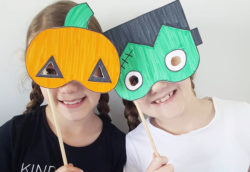Does talking about unschooling creativity in children shock or astonish you? This incredibly unique concept of self-learning that parents and kids are confident about is a quintessential example of doing the same things differently which is shouted out loud as ‘out of the box thinking’
The efficacy of Unschooling Child Creativity relies on the parent’s efforts in guiding the child on how to become independent and the child’s ability and interest to acclimatize to this sort of learning.
Unschoolers walk beyond restrictions and come out in flying colors inculcating new skills and develop themselves, work towards sharpening their IQ single-handed with no hard and fast rules tied to it.
As per a quote, ‘Every child is an artist, until he is told he is not an artist’ – It is our responsibility to feed that optimism in a child.
Let us walk through to see how can we foster and extend our helping hand as parents or relatives to the unschoolers to whet their creativity.
What is Unschooling a Child?

The conception of unschooling is similar to that of homeschooling. Yet, with the existing similarity that a child’s education is taken care of at home, the dissimilarity here is the technique followed. Homeschooling is narrow whereas unschooling is broad.
Parents play a role in helping unschooling creativity in a child develop in the right direction by being like a guide and helping them solve doubts they come across.
It is alone the decision of the child to indulge in learning what he or she wants. Parents are like a wall the child can lean on for help. Parents giving the child their inputs on various subjects and the child takes that guidance to climb up the ladder of learning.
Unschooling is legal in some countries and is not followed at some places. This kind of learning comes with its set of pros and cons.
There are more of advantages to this kind of learning, the child’s learning style is as independent and unique as possible, there is no end to a child’s imagination right from being a kid to the times they grow up and go for further studies.
Contrarily, the child is not around a circle of people and may not be able to relate with how to share knowledge and may not be able to understand what is a classroom experience like. Basically more in a cocoon missing out on experiencing people and the fun that one can have in school.
Unschooling does not have an age bar, it can be done at any age. One can become an unschooler even when the person is eligible to go to University.
Unschooling has a great scope provided the child and parent are confident of taking up this child-led training. There are chances that the effectiveness of this technique can dip down in cases when the parent is failing to devote time to the child or this sort of training is not what the child wants.
In order to derive success from this type of learning, parents must take out time and brain-storm on the tactics they can apply to see how ideas can be used to unschooling their child’s creativity.
Unschooling child creativity will not be difficult if you get on the table a plan of how to make it super interesting for your child. Let’s take a look at tactics of Unschooling child creativity.
Tactic No 1 – Go Easy With Your Child

“I am always ready to learn, But did not always like being taught”. This was a quote said by Winston Churchhill.
This describes it all, to begin with, a child may be great at art and craft and may want to get in-depth to master and explore all the craft ideas.
Do not impose your ideas and create a situation wherein your child loses interest in what he/she is interested to expand in terms of gaining knowledge.
Go easy on your child, let your child pick something for himself/herself. Wondering on how to teach important skills to your child? Just allow them to choose what they like.
Tactic No 2 – Focus on Helping The Child Relate With the Subject

A practical approach to everything that we theoretically learn registers faster in our minds than that which is just being taught in the subjective sense.
Having said that, this sounds like finding out a way to grow many more flowers in the same flower pot.
To help you further, for instance, you are teaching addition to your child. First you must keep things handy for your child, then start to show them things and say 1 2 3 4 along with them. This is a cinched example. This way, find ways where you can make your teaching sessions fun for the child.
Tactic No 3 – Do Not Merely Teach But Guide Your Child

There is a difference in following rules while teaching your child and there is a difference in just guiding them with their own learning.
The purpose of unschooling loses its relevance when a parent starts to teach the child with set rules.
Guide the child in such a way that the child does not feel like running away from you rather your child feels like looking up to you for help.
When you have an approachable attitude with your child, this in itself becomes a strong point to help you while you are aiming on developing child’s creativity.
They don’t feel caged and there is a nuisance of the child feeling burdened about learning.
Tactic 4 – Make Learning Fun

When you would have been a child and gone to school. Learning would be stringent. But times have drastically changed and now there are numerous things one can do to make learning fun.
To support this explanation with an idea, you can work on pictorial presentation while guiding your child, you can use books as well as videos while you guide your child.
Apart from this, when your child is learning mathematics you can play music to lighten the child’s state of mind.
You can teach your child about a concept presenting it like a story if your child is keen on listening to stories. This tactic comes along with two benefits.
- Your child is learning easily without distractions
- Your child’s imagination power shoots up.
Tactic No 6 – Do not be Staunch on Rules

It is necessary that a child needs to learn about discipline in life, it can be taught a better way.
A better way to teach your child about rules and discipline is by not setting any timelines or imposing a forcible pressure on your child’s mind to complete a task.
All you need to do is, talk to your child about how he can do good if he has a disciplined lifestyle and leave the decision to your child.
When things are imposed a child tends to go against it. But when you put it to them without imposing it on them, at some point in time they understand. Don’t kill the unschooling creativity of your child even before it develops.
Tactic No 7 – Inculcate Interactive Learning

We seldom realize the fact that we can learn from our children too. While your child is learning a particular subject and seeks help from you. Express all you know about the subject and keep your child involved in responding back to you as well.
Make it like an interactive learning time, give room to your child to express ideas gushing out of his/her mind.
The benefit of this sort of learning doesn’t let your child be bored.
Tactic No 8 – Render to Your Childs Material Needs

Do not shut options for your child if your child wants to buy project materials to learn a subject better unless it is a genuine reason that you cannot afford it do not stop your child, render all that your child needs.
When you provide all the essentials to a child to polish their learning they are more than happy to explore further.
They may tend to waste some things as it might not be useful to them. Getting aware step by step your child would also learn the importance of how much and how to use things from an early age
Tactic No 9 – Say Kudos When They Do Good

Encouragement is the key for a child to feel acknowledged and motivated. When we as adults are happy being appreciated for the good work we do, the same with the little children.
The more you give them a pat for the good they do, the more they will have a positive attitude towards learning and they will never be de-motivated. This way of developing an unschooling child’s creativity will work wonders.
Tactic No 10 – Take your Child’s Talent Seriously

It is a must for parents to understand what is the child good at. If you think your child is good at dancing, music or art, see to it that your child invests time to pursue their interest.
Hobbies should never be neglected as passion brings out the best in us. Investing in a hobby and getting better at it each day, boosts confidence, gives the child an opportunity of valuing themselves better.
Tactic No 11 – Play the Puzzle Game

If your child is willing to indulge in puzzle-solving. Give your child puzzles to solve each day for at least 15 minutes, it will be a break for the child as well as broaden the child’s creativity as well as problem-solving capabilities.
The best puzzle games could be brain teasing activities, building blocks, jigsaw etc. They are fun, colorful and engaging.
Tactic No 12 – Involve your Child in a Physical Activity

Although your child is an unschooler, you can still encourage your child to get involved in a sport. The more the child is involved in physical activity the more his/her creativity increases and as the creativity increases will the child perform well in learning better.
Tactic No 13 – Educate your Child to be Expressive About Ideas

No idea is right or wrong, everything is just new learning. You must teach the same thing to your child, give them that comfort that they can share their ideas with you.
Encourage your child to always jot down ideas, whether workable or not. When children gather their ideas they tend to get into the habit of thinking, which is a great unschooling creativity idea for your child.
Tactic No 14 – Co-Operate When Your Child Steps on the Wrong Track

Do not make it a big deal if your child has made a mistake, make your child understand the same that it is not wrong to make mistakes.
Only when the child makes a mistake will he/she understand where he/she can do better. Once, your child makes a mistake the next time he/she will be better at learning that task.
Tactic No 15 – Introduce Your Child to The World of Colors

It is said by researches that coloring improves a child’s creativity and reduces their stress level, the mood of a child is re-defined.
When a child’s mood, creativity and stress levels are in place, a child is prone to feel fresh while learning and the mind is open to welcome new thoughts and when the imagination is ahead of expectations the results-driven are innovative and phenomenal.
Tactic No 16 – Help them Practice Understanding Their Senses

The idea behind probing a question to your child is to help them come in terms with their senses. Put them in situations where you can probe questions and they will use their senses to answer you.
For instance, when you take your child out ask your child and you are stuck in the traffic, ask your child what do they see, what can they hear and how do they feel.
The more they relate with their senses, the better they get to know about their body and the better they understand on how to respond to the conditions in and around them.
In terms of unschooling child’s creativity, this will teach a child the probability to react instantly, which is necessary for them to learn from the beginning.
All in all, talking of how a child carves his/her creativity is very vague and cannot be defined, it varies from one child to the other Put together, all the ideologies and thoughts on unschooling child creativity and it can be understood as self-made choice and it is a platform where the learning and curriculum of an unschooler is unlike a schooler.
If your child is an unschooler and you are thinking if it is the ultimate choice you have made, then you must know, it is an ultimate choice!
-Neha Makhija










































